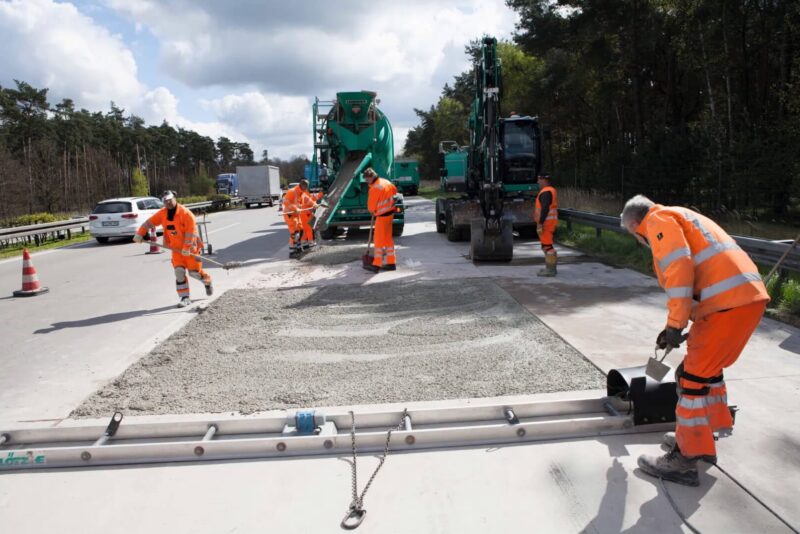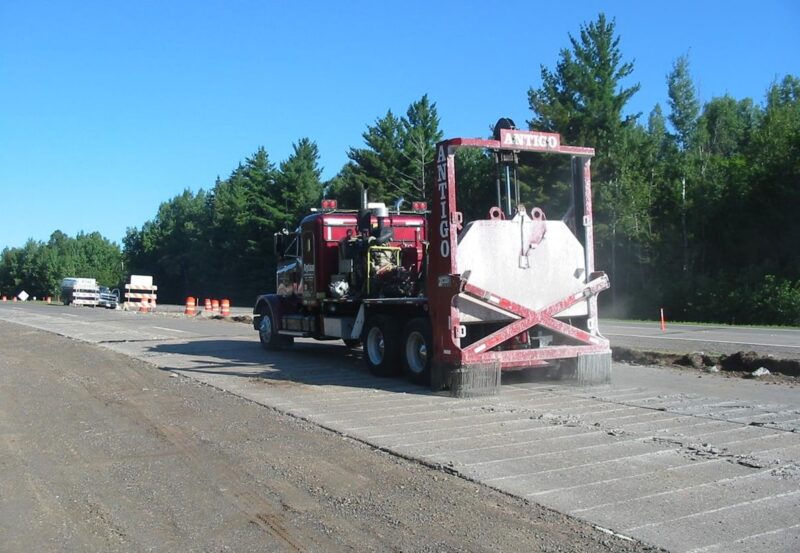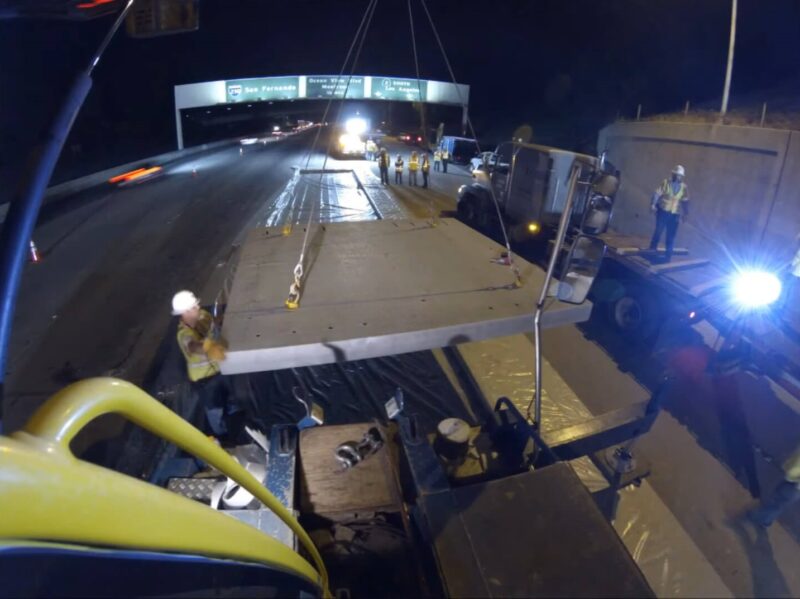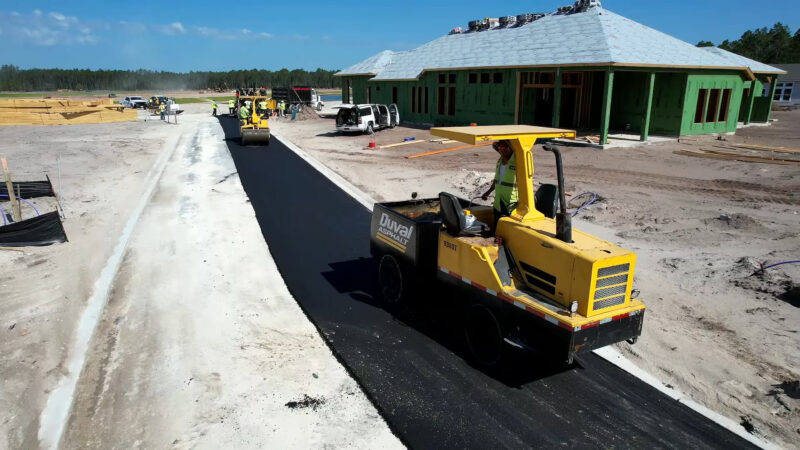Concrete paving is a crucial component of modern infrastructure, offering durability, versatility, and cost-effectiveness. Different types of concrete paving are employed based on the specific requirements of each project, including factors like traffic loads, environmental conditions, and budget constraints.
This article explores the various types of concrete paving, providing detailed insights into their construction methods, applications, advantages, and technical data.
Jointed Plain Concrete Pavement (JPCP)
Jointed Plain Concrete Pavement (JPCP) consists of slabs with joints spaced at regular intervals to control cracking. These joints typically placed 4.5 to 6 meters apart, are necessary to accommodate the natural expansion and contraction due to temperature changes and shrinkage. JPCP is one of the most commonly used methods due to its simplicity and cost-effectiveness.
Construction Details

JPCP construction involves the following steps:
- Subgrade Preparation: The subgrade is prepared and compacted to provide a stable base for the slabs.
- Base Layer: A base layer, often made of granular material or cement-treated base, is placed to provide additional support.
- Formwork and Reinforcement: Forms are set up to define the slab boundaries, and dowel bars are placed at the joints to ensure load transfer between slabs.
- Concrete Placement: It is poured, spread, and leveled within the forms. It is then compacted using vibrators to eliminate air pockets and achieve the desired density.
- Joint Cutting: Once it gains initial strength, joints are cut to control cracking. These cuts are typically made one-quarter to one-third of the slab thickness.
- Curing: It is cured to achieve the required strength and durability.
Applications
JPCP is widely used in:
- Highways
- Urban roads
- Airport runways
- Parking lots
Advantages
- Cost-Effective: JPCP is economical for large-scale projects due to its straightforward construction process.
- Durability: Properly constructed JPCP can last several decades with minimal maintenance.
- Flexibility: Suitable for various traffic loads and environmental conditions.
Jointed Reinforced Concrete Pavement (JRCP)
Jointed Reinforced Concrete Pavement (JRCP) incorporates steel reinforcement within the slabs. The joints in JRCP are spaced farther apart than in JPCP, allowing for longer slabs and reducing the number of joints. The steel reinforcement helps control cracking and enhances the pavement’s load-carrying capacity.
Construction Details

The construction process for JRCP includes:
- Subgrade and Base Layer Preparation: Similar to JPCP, the subgrade is prepared and a base layer is placed.
- Formwork and Reinforcement Placement: Forms are set up, and steel reinforcement (typically rebar) is placed within the slab. The reinforcement is positioned to control cracking and improve load distribution.
- Concrete Placement and Compaction: Concrete is poured over the reinforcement, spread, and compacted.
- Joint Cutting and Sealing: Joints are cut at wider intervals compared to JPCP, and they are sealed to prevent water infiltration and freeze-thaw damage.
- Curing: To achieve optimal strength.
Applications
JRCP is ideal for:
- Heavy-load roads
- Industrial areas
- Airport aprons
Advantages
- Reduced Joint Spacing: Fewer joints lead to less maintenance and improved ride quality.
- Enhanced Durability: Steel reinforcement provides additional strength and extends the pavement’s life.
Continuously Reinforced Concrete Pavement (CRCP)
Continuously Reinforced Concrete Pavement (CRCP) eliminates the need for conventional transverse joints by incorporating continuous steel reinforcement throughout the pavement. This reinforcement controls cracking, resulting in a highly durable and low-maintenance pavement.
Construction Details

CRCP construction involves:
- Subgrade and Base Preparation: The subgrade is compacted, and a base layer is applied.
- Reinforcement Placement: Continuous steel reinforcement is placed throughout the pavement, usually positioned near the mid-depth of the slab.
- Concrete Placement: Poured over the reinforcement, spread, and compacted.
- Curing: To develop the desired strength and durability.
Applications
CRCP is used in:
- High-traffic areas
- Industrial yards
- Airport runways
Advantages
- Long-Term Performance: CRCP provides excellent long-term performance with minimal maintenance.
- Superior Load-Carrying Capacity: Continuous reinforcement ensures enhanced load distribution and resistance to heavy traffic.
Roller Compacted Concrete (RCC)
Roller Compacted Concrete (RCC) is a type of concrete that is placed and compacted using heavy rollers. RCC combines the benefits of traditional concrete and asphalt, offering high strength and rapid construction.
Construction Details

RCC construction involves:
- Subgrade and Base Preparation: The subgrade is compacted, and a base layer is applied.
- Concrete Mixing: A mix with minimal water content is prepared.
- Concrete Placement and Compaction: The mix is spread using asphalt pavers and compacted with heavy rollers to achieve the desired density and strength.
- Curing: RCC is cured to ensure adequate strength development.
Applications
RCC is suitable for:
- Industrial pavements
- Low-traffic roads
- Parking lots
Advantages
- Rapid Construction: RCC allows for quick construction, making it ideal for projects with tight schedules.
- High Strength: RCC provides excellent load-carrying capacity and durability.
Concrete Overlays
Concrete overlays involve placing a new layer over an existing pavement surface. This method is used to repair and strengthen existing pavements without complete reconstruction.
Construction Details
The overlay process includes:
- Surface Preparation: The existing pavement surface is cleaned and prepared to ensure proper bonding with the overlay.
- Concrete Placement: A new layer is placed over the prepared surface.
- Finishing and Curing: The overlay is finished to the desired texture and cured to develop the required strength.
Applications
Concrete overlays are used for:
- Pavement rehabilitation
- Cost-effective repairs
Advantages
- Extended Pavement Life: Overlays extend the life of existing pavements.
- Cost-Effective: They offer a cost-effective alternative to full-depth reconstruction.
Precast Concrete Paving
Precast involves manufacturing elements off-site and then assembling them on-site. This method offers various design options and accelerates construction.
Construction Details

Precast paving includes:
- Element Manufacturing: Concrete elements are cast and cured in a controlled environment.
- Transportation and Assembly: The precast elements are transported to the construction site and assembled.
- Joint Sealing and Finishing: Joints between precast elements are sealed, and the pavement is finished to the desired texture.
Applications
ideal for:
- Urban areas with architectural requirements
- Projects with tight schedules
Advantages
- Accelerated Construction: Precast elements reduce on-site construction time.
- Customizable Design: They offer various design options, including intricate patterns and textures.
Asphalt Concrete Paving
Although not technically a type of concrete paving, asphalt is a prevalent alternative for road construction. It consists of asphalt binder mixed with aggregates and offers flexibility and quick construction.
Construction Details

Asphalt paving involves:
- Subgrade and Base Preparation: The subgrade is compacted, and a base layer is applied.
- Asphalt Mixing: Aggregates and asphalt binder are mixed to form a hot mix.
- Placement and Compaction: The hot mix is spread and compacted to form a durable pavement surface.
- Cooling and Curing: The asphalt is allowed to cool and harden.
Applications
Asphalt is used for:
- Roads and highways
- Parking lots
- Urban streets
Advantages
- Flexibility: Asphalt pavements can withstand minor movements in the underlying soil.
- Quick Construction: Asphalt paving projects can be completed quickly, minimizing traffic disruptions.
Conclusion
Choosing the right type of concrete paving is crucial for the success and longevity of infrastructure projects. JPCP and JRCP offer cost-effective solutions for roads and highways.
CRCP provides superior durability and load-carrying capacity for high-traffic areas. RCC offers rapid construction for industrial pavements, while overlays extend the life of existing pavements. Precast concrete paving accelerates construction and provides customizable design options. Although not a concrete pavement, asphalt concrete offers a flexible and quick alternative for various applications.

